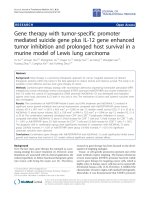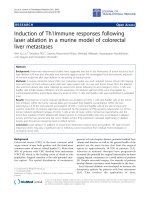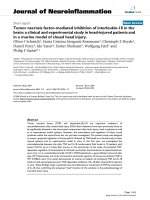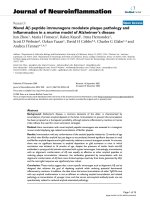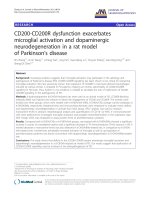Hydrogen sulfide and neurogenic inflammation in a murine model of polymicrobial sepsis
Bạn đang xem bản rút gọn của tài liệu. Xem và tải ngay bản đầy đủ của tài liệu tại đây (7.26 MB, 243 trang )
HYDROGEN SULFIDE AND NEUROGENIC
INFLAMMATION IN A MURINE MODEL OF
POLYMICROBIAL SEPSIS
ANG SEAH FANG
(B.Sc. (Hons.), National University of Singapore)
A THESIS SUBMITTED
FOR THE DEGREE OF DOCTOR OF PHILOSOPHY
NUS GRADUATE SCHOOL FOR INTEGRATIVE
SCIENCES AND ENGINEERING
NATIONAL UNIVERSITY OF SINGAPORE
2011
i
ACKNOWLEDGEMENTS
It is a pleasure to thank the many people who made this dissertation possible.
First and foremost, I would like to express my deepest gratitude to my supervisor,
Professor Madhav Bhatia, for giving me confidence and support to begin my Ph.D
studies. Professor Bhatia offered me so much advice, patiently supervising me, and
always guiding me in the right direction. His passion for research, his stringent
scientific attitude, and his perseverant spirits have been of great value to me.
Special thanks are also given to my other supervisor, Associate Professor Paul A.
MacAry. He is the one who accepted me as his student without any hesitation during
the critical period of my Ph.D studies. He helped me immensely by giving me
encouragement, guidance, supervison, and understanding throughout this work. It is
not sufficient to express my gratitude with only a few words.
I would also like to thank my co-supervisor, Associate Professor Shabbir M.
Moochhala, for his engaging and proactive guidance. He has shared with me his
invaluable insights on the animal model of polymicrobial sepsis. I appreciate all his
contributions of time and ideas to make my Ph.D experience productive and
stimulating.
NUS Graduate School for Integrative Sciences and Engineering (NGS) has extended a
great deal of support and ensured that I received a quality graduate education that will
put me on the forefront of global competition. For that, I am truly thankful to NGS for
ii
providing me with a generous scholarship as well as ample opportunities to shine and
learn as a graduate student.
My heartfelt appreciation also goes to Associate Professor Khanna Sanjay. I would
like to thank him for his unselfish and unfailing support as my dissertation adviser. I
am very grateful to Shoon Mei Leng, our laboratory officer, for her willingness to
always go the extra mile to help me in my experiments and for excellent help in
technical procedures. I would also like to thank the staff of Department of
Pharmacology, especially Ting Wee Lee and Koh Yoke Moi, who have extended their
warmest help to facilitate my Ph.D project.
Special thanks also go to my fellow laboratory mates, Dr. Akhil Hegde, Dr. He Min,
Dr. Jenab Nooruddinbhai Sidhapuriwala, Dr. Pratima Shrivastava, Dr. Raina Devi
Ramnath, Dr. Ramasamy Tamizhselvi, Dr. Sun Jia, Dr. Zhang Huili, Dr. Zhang Jing,
Dr. Muthu Kumaraswamy Shanmugam, Dr. Zhi Liang, Dr. Lee Jan Hau, Andy Yeo
Yee, Koh Yung Hua, Sagiraju Sowmya, Yada Swathi, Yeo Ai Ling, and Abel Damien
Ang for insightful discussions, moral support, and encouragement.
Last but not least, I am greatly indebted to my family members for their support, love,
and understanding so that I could come so far in life.
iii
TABLE OF CONTENTS
A
CKNOWLEDGEMENTS
i
T
ABLE OF
C
ONTENTS
iii
S
UMMARY
ix
L
IST OF
T
ABLES
xii
L
IST OF
F
IGURES
xiii
L
IST OF
A
BBREVIATIONS
xvi
P
UBLICATIONS
xx
C
HAPTER
I
I
NTRODUCTION
1
1.1 General overview
1
1.2 H
2
S
3
1.2.1 Chemical properties of H
2
S
3
1.2.2 H
2
S Toxicity
4
1.2.3 Biosynthesis of H
2
S
5
1.2.4 Metabolism of H
2
S
9
1.2.5 Biological roles of H
2
S
9
1.2.5.1 Roles of H
2
S in CNS
10
1.2.5.1.1 Physiological roles of H
2
S in CNS
10
1.2.5.1.2 H
2
S in CNS diseases
12
1.2.5.2 Roles of H
2
S in cardiovascular system
15
1.2.5.2.1 Physiological roles of H
2
S in cardiovascular system
15
1.2.5.2.2 H
2
S in cardiovascular diseases
18
1.2.5.3 Roles of H
2
S in gastrointestinal system
21
1.2.5.3.1 Physiological roles of H
2
S in gastrointestinal system
21
1.2.5.3.2 H
2
S in gastrointestinal diseases
25
1.2.5.4 Roles of H
2
S in endocrine system
26
iv
1.2.5.5 Roles of H
2
S in reproductive system
28
1.2.5.6 Roles of H
2
S in inflammation
28
1.2.5.6.1 Pro-inflammatory roles of H
2
S
31
1.2.5.6.2 Anti-inflammatory roles of H
2
S
42
1.2.5.6.3 H
2
S and neurogenic inflammation
45
1.3 Sepsis
55
1.3.1 Definition of sepsis
55
1.3.2 Epidemiology of sepsis
57
1.3.3 Pathophysiology of sepsis
58
1.3.4 Animal models of sepsis
61
1.3.4.1 Toxemia models
61
1.3.4.2 Bacterial infection models
62
1.3.4.3 Host-barrier disruption models
63
C
HAPTER
II
R
ESEARCH
R
ATIONALE AND
O
BJECTIVES
66
2.1 Question of interest
66
2.2 Approach
68
2.3 Objectives
69
C
HAPTER
III
H
2
S
P
ROMOTES
TRPV1-M
EDIATED
N
EUROGENIC
INFLAMMATION IN POLYMICROBIAL SEPSIS
70
3.1 Introduction
70
3.2 Materials and methods
71
3.2.1 Induction of sepsis
71
3.2.2 Measurement of MPO activity
73
3.2.3 Measurement of plasma H
2
S
73
3.2.4 Assay of liver CSE activity
74
3.2.5 Histopathological examination
74
3.2.6 Survival studies
75
v
3.2.7 Statistics
75
3.3 Results
75
3.3.1 Capsazepine attenuates systemic inflammation and multiple organ
damage in sepsis
75
3.3.2 Capsazepine has no effect on endogenous generation of H
2
S in sepsis
77
3.3.3 Capsazepine protects against mortality in CLP-induced sepsis
77
3.3.4 Capsazepine reverses the pro-inflammatory effects of NaHS in sepsis
78
3.3.5 Capsazepine protects against NaHS-augmented mortality in CLP-
induced sepsis
79
3.3.6 Capsazepine has no effect on blockade of endogenous generation of
H
2
S in sepsis
79
3.3.7 Capsazepine has no effect on PAG-mediated attenuation of pro-
inflammatory effects of H
2
S in sepsis
80
3.3.8 Capsazepine has no effect on PAG-mediated protection of mortality
in CLP-induced sepsis
81
3.4 Discussion
81
C
HAPTER
IV
H
2
S
P
ROMOTES
TRPV1-M
EDIATED
N
EUROGENIC
INFLAMMATION IN POLYMICROBIAL SEPSIS THROUGH
ENHANCEMENT OF SP PRODUCTION
98
4.1 Introduction
98
4.2 Materials and methods
100
4.2.1 Induction of sepsis
100
4.2.2 Measurement of SP levels
100
4.2.3 Cytokines, chemokines, and adhesion molecules analysis
101
4.2.4 Reverse transcriptase-polymerase chain reaction analysis
101
4.2.5 Measurement of pulmonary edema
102
4.2.6 Alanine aminotransferase and aspartate aminotransferase assay
102
4.2.7 Statistics
102
4.3 Results
103
4.3.1 Capsazepine attenuates endogenous SP concentrations in both septic
and septic mice administrated with NaHS
103
vi
4.3.2 The attenuated SP concentration correlates with reduced production
of pro-inflammatory molecules in both septic and septic mice
administrated with NaHS
104
4.3.3 Capsazepine protects against MODS in both septic and septic mice
administrated with NaHS
105
4.3.4 Capsazepine has no effect on PAG-mediated attenuation of SP levels
in sepsis
106
4.3.5 Inhibition of H
2
S formation impaired pro-inflammatory molecules
production after septic injury, but capsazepine has no effect on them
106
4.3.6 Beneficial effects of capsazepine and PAG are not additive in
protection against MODS in sepsis
107
4.4 Discussion
107
C
HAPTER
V
H
2
S
P
ROMOTES
TRPV1-M
EDIATED
N
EUROGENIC
INFLAMMATION IN POLYMICROBIAL SEPSIS BY ACTIVATING
ERK1/2 AND NF-ΚB SIGNALING PATHWAYS
136
5.1 Introduction
136
5.2 Materials and methods
138
5.2.1 Induction of sepsis
138
5.2.2 Nuclear extraction and measurement of NF-κB activation
138
5.2.3 Western immunoblot
138
5.2.4 Statistics
139
5.3 Results
140
5.3.1 Effect of capsazepine on ERK1/2 activation in H
2
S-induced
neurogenic inflammation in sepsis
140
5.3.2 Effect of capsazepine on IκBα phosphorylation and degradation
levels in H
2
S-induced neurogenic inflammation in sepsis
140
5.3.3 Effect of capsazepine on NF-κB activation in H
2
S-induced
neurogenic inflammation in sepsis
141
5.4 Discussion
142
vii
C
HAPTER
VI
H
2
S
A
UGMENTS
COX-2
AND
P
ROSTAGLANDIN
E
2
METABOLITE PRODUCTION IN SEPSIS-EVOKED ACUTE LUNG
INJURY BY A TRPV1 CHANNEL-DEPENDENT MECHANISM
152
6.1 Introduction
152
6.2 Materials and methods
153
6.2.1 Induction of sepsis
153
6.2.2 Measurement of COX-2 activity
154
6.2.3 Measurement of PGE
2
metabolite levels
154
6.2.4 Western immunoblot
154
6.2.5 Measurement of MPO activity
154
6.2.6 Histopathogical examination
155
6.2.7 Cytokines, chemokines, and adhesion molecules analysis
155
6.2.8 Measurement of pulmonary edema
155
6.2.9 Survival studies
155
6.2.10 Statistics
155
6.3 Results
155
6.3.1 H
2
S regulates COX-2 levels in septic lungs in a TRPV1 channel-
dependent manner
155
6.3.2 The H
2
S-augmented, TRPV1-dependent COX-2 response correlates
with concurrent PGE
2
metabolite production following septic injury
156
6.3.3 COX-2 inhibition prevents H
2
S from aggravating ALI in sepsis
157
6.3.4 Blockade of H
2
S-mediated activation of COX-2 impaired pro-
inflammatory cytokines, chemokines and adhesion molecules
production in sepsis-induced ALI
158
6.3.5 Inhibition of COX-2 attenuates H
2
S-augmented PGE
2
metabolite
production in septic lungs
159
6.3.6 Inhibition of COX-2 protects against H
2
S-augmented, CLP-induced
lethality, but has no effect on PAG-mediated protection of mortality
in sepsis
159
6.4 Discussion
160
viii
C
HAPTER
VII
G
ENERAL
D
ISCUSSION AND
C
ONCLUSION
180
7.1 Significance of findings
180
7.2 Limitations of the study
184
7.3 Conclusions and future perspectives
185
R
EFERENCES
189
ix
SUMMARY
Hydrogen sulfide (H
2
S), a malodorous gas with the characteristic odor of rotten eggs,
has been recognized as an important endogenous gaseous signaling molecule of the
cardiovascular, gastrointestinal, genitourinary, and nervous systems. Besides acting as
a potent vasodilator and an atypical neuromodulator, H
2
S is increasingly being
established as a novel mediator of inflammation. However, the part played by H
2
S in
modulating neurogenic inflammatory response in sepsis is not known. Therefore, this
study aimed to investigate the role of H
2
S in mediating neurogenic inflammation in a
mouse model of polymicrobial sepsis induced by cecal ligation and puncture (CLP).
Of major significance in the development of neurogenic inflammation is the transient
receptor potential vanilloid type 1 (TRPV1) receptor, a non-selective cation channel
found predominantly in primary sensory neurons. In particular, the results of the
present study indicate that H
2
S promotes TRPV1-mediated neurogenic inflammation
in sepsis. It was found that capsazepine, a selective receptor antagonist of TRPV1,
significantly attenuated systemic inflammation and multiple organ damage caused by
CLP-induced sepsis under the pro-inflammatory impact of H
2
S. Capsazepine also
delayed the onset of lethality and protected against sepsis-associated mortality.
Administration of sodium hydrosulfide, an H
2
S donor, exacerbated but capsazepine
reversed deleterious effects of sepsis. In the presence of DL-propargylglycine, an
inhibitor of endogenous H
2
S synthesis, capsazepine caused no further changes to the
DL-propargylglycine-mediated attenuation of systemic inflammation, multiple organ
damage, and mortality in sepsis. Moreover, capsazepine had no effect on endogenous
x
generation of H
2
S, suggesting that H
2
S is located upstream of TRPV1 activation, and
may play a critical role in regulating the release of sensory neuropeptides in sepsis.
Importantly, the neuropeptide substance P has been identified as an important
endogenous neural mediator that is implicated in H
2
S-driven neurogenic inflammation
in sepsis in a TRPV1 channel-dependent manner. Furthermore, the H
2
S-induced
neurogenic inflammatory response following septic insults was found to be regulated
by the activation of extracellular signal-regulated kinase 1/2 (ERK1/2) and nuclear
factor-κB (NF-κB) pathways. In addition, our results indicate that H
2
S augmented
cyclooxygenase-2 (COX-2) and prostaglandin E
2
(PGE
2
) metabolite production in
septic lungs by a TRPV1 channel-dependent mechanism. Notably, COX-2 inhibition
with parecoxib attenuated H
2
S-augmented lung PGE
2
metabolite production,
neutrophil infiltration, edema, pro-inflammatory cytokines, chemokines, and adhesion
molecules levels, restored lung histoarchitecture, and protected against CLP-induced
lethality.
In summary, the present study suggests that endogenous H
2
S induces TRPV1-
mediated neurogenic inflammation in polymicrobial sepsis through the enhancement
of substance P production and activation of the ERK-NF-κB signal transduction
pathways. In addition, H
2
S works in conjunction with other prominent mediators of
inflammation such as COX-2 and PGE
2
in a TRPV1-dependent manner, thereby
contributes to sepsis-evoked acute lung injury. Finally, our data also indicate that
blockade of TRPV1 channels provides potent anti-inflammatory effects and
protection against multi-organ injury and mortality in sepsis, thus highlighting the
xi
potential utility of TRPV1 antagonist as a promising therapeutic target for the
management of sepsis and its associated complications in critically ill patients.
xii
LIST OF TABLES
Table 1.1
Diagnostic criteria for sepsis
56
Table 1.2
Standard definitions for sepsis and sepsis-associated conditions
57
Table 4.1
PCR primer sequences, optimal conditions, and product sizes
103
xiii
LIST OF FIGURES
Figure 1.1
Enzymatic pathway of H
2
S production in mammalian cells
7
Figure 1.2
Non-enzymatic pathway of H
2
S production in erythrocytes
8
Figure 1.3
Metabolism of H
2
S
10
Figure 1.4
Neural modulation of inflammation
46
Figure 1.5
Membrane topology of TRPV1 channel
48
Figure 1.6
Involvement of TRPV1 in the mechanism of neurogenic
inflammation
49
Figure 1.7
Biosynthesis of SP and related tachykinin peptides
51
Figure 1.8
The CLP and CASP models of sepsis
65
Figure 3.1
Effect of capsazepine on lung and liver MPO activity in septic
mice
87
Figure 3.2
Effect of capsazepine on CLP-induced lung and liver injury in
septic mice
88
Figure 3.3
Lack of effect of capsazepine on liver CSE enzyme activity and
plasma H
2
S level in septic mice
89
Figure 3.4
Effect of capsazepine on CLP-induced mortality in septic mice
90
Figure 3.5
Effect of NaHS and capsazepine on lung and liver MPO
activity in septic mice
91
Figure 3.6
Effect of NaHS and capsazepine on lung and liver injury in
septic mice
92
Figure 3.7
Effect of NaHS and capsazepine on CLP-induced mortality in
septic mice
93
Figure 3.8
Effect of PAG and capsazepine on liver CSE enzyme activity
and plasma H
2
S level in septic mice
94
Figure 3.9
Effect of PAG and capsazepine on lung and liver MPO activity
in septic mice
95
Figure 3.10
Effect of PAG and capsazepine on lung and liver injury in
septic mice
96
Figure 3.11
Effect of PAG and capsazepine on CLP-induced mortality in
septic mice
97
xiv
Figure 4.1
Effect of NaHS and capsazepine on lung and plasma SP levels,
and lung PPT-A mRNA expression in septic mice
112
Figure 4.2
Effect of NaHS and capsazepine on protein levels of cytokines
and chemokines in the lung and liver of septic mice
114
Figure 4.3
Effect of NaHS and capsazepine on mRNA expression of
cytokines and chemokines in the lung and liver of septic mice
116
Figure 4.4
Effect of NaHS and capsazepine on protein levels of adhesion
molecules in the lung and liver of septic mice
118
Figure 4.5
Effect of NaHS and capsazepine on mRNA expression of
adhesion molecules in the lung and liver of septic mice
120
Figure 4.6
Effect of NaHS and capsazepine on plasma ALT and AST
activities, and pulmonary edema (measured as lung wet-to-dry
weight ratio) in septic mice
122
Figure 4.7
Effect of PAG and capsazepine on lung and plasma SP levels,
and lung PPT-A mRNA expression in septic mice
124
Figure 4.8
Effect of PAG and capsazepine on protein levels of cytokines
and chemokines in the lung and liver of septic mice
126
Figure 4.9
Effect of PAG and capsazepine on mRNA expression of
cytokines and chemokines in the lung and liver of septic mice
128
Figure 4.10
Effect of PAG and capsazepine on protein levels of adhesion
molecules in the lung and liver of septic mice
130
Figure 4.11
Effect of PAG and capsazepine on mRNA expression of
adhesion molecules in the lung and liver of septic mice
132
Figure 4.12
Effect of PAG and capsazepine on plasma ALT and AST
activities, and pulmonary edema (measured as lung wet-to-dry
weight ratio) in septic mice
134
Figure 5.1
Effect of NaHS or PAG and capsazepine on ERK1/2 activation
in the lung and liver of septic mice
145
Figure 5.2
Effect of NaHS or PAG and capsazepine on phospho-IκBα
expression levels in the lung and liver of septic mice
147
Figure 5.3
Effect of NaHS or PAG and capsazepine on IκBα expression
levels in the lung and liver of septic mice
149
Figure 5.4
Effect of NaHS or PAG and capsazepine on NF-κB activation
in nuclear extracts of lung and liver tissues in septic mice
151
Figure 6.1
Effect of NaHS and capsazepine on protein expression and
activity of COX-2 in septic lungs
166
xv
Figure 6.2
Effect of PAG and capsazepine on protein expression and
activity of COX-2 in septic lungs
168
Figure 6.3
Effect of NaHS or PAG and capsazepine on PGE
2
metabolite
production in septic lungs
170
Figure 6.4
Effect of NaHS and parecoxib on lung MPO activity,
histopathological evaluation (hematoxylin and eosin staining)
of lung polymorphonuclear leukocyte infiltration and injury,
and pulmonary edema in sepsis
171
Figure 6.5
Effect of NaHS and parecoxib on production of pro-
inflammatory cytokines and chemokines in septic lungs
173
Figure 6.6
Effect of NaHS and parecoxib on production of adhesion
molecules in septic lungs
175
Figure 6.7
Effect of NaHS and parecoxib on production of PGE
2
metabolite in septic lungs
177
Figure 6.8
Effect of parecoxib on CLP-induced mortality in septic mice,
septic mice injected with NaHS, septic mice received
prophylactic PAG, and septic mice received therapeutic PAG
178
Figure 7.1
Flowchart summarizing the pro-neuroinflammatory role of H
2
S
in polymicrobial sepsis
188
xvi
LIST OF ABBREVIATIONS
3-MST
3-mercaptopyruvate sulfurtransferase
AC
adenylyl cyclase
AECOPD
Acute exarcebation of chronic obsructive pulmonary disease
ALI
Acute lung injury
ALT
Alanine aminotransferase
ANOVA
Analysis of variance
ARDS
Acute respiratory distress syndrome
AST
Aspartate aminotransferase
ATP
Adenosine triphosphate
Capz
Capsazepine
CASP
Colon ascendens stent peritonitis
CAT
Cysteine aminotransferase
CBS
Cystathionine-β-synthase
CGRP
Calcitonin gene-related peptide
CLP
Cecal ligation and puncture
CNS
Central nervous system
CO
Carbon monoxide
COPD
Chronic obsructive pulmonary disease
COX
Cyclooxygenase
CSE
Cystathionine-γ-lyase
DMSO
Dimethyl sulfoxide
DTT
Dithiothreitol
ELISA
Enzyme-linked immunosorbent assay
ERK
Extracellular signal-regulated kinase
GABA
γ-aminobutyric acid
GNMT
Glycine N-methyltransferase
xvii
GSH
Glutathione
h
Hour(s)
H
2
S
Hydrogen sulfide
HPH
Hypoxic pulmonary hypertension
HPRT
Hypoxanthine-guanine phosphoribosyltransferase
HRP
Horeradish peroxidase
i.p.
Intraperitoneal
i.v.
Intravenous
ICAM-1
Intercellular adhesion molecule-1
ICUs
Intensive care units
IL
Interleukin
IκBα
Inhibitory κBα
JNK
c-Jun N-terminal kinases
L-NAME
NG-nitro-
L
-arginine
LPS
Lipopolysaccharide
MAPKs
Mitogen-activated protein kinases
MAT
Methionine adenosyltransferase
MCP
Monocyte chemotactic protein
min
Minutes
MIP
Macrophage inflammatory protein
MODS
Multiple organ dysfunction syndrome
MPO
Myeloperoxidase
NaHS
Sodium hydrosulfide
NF-κB
Nuclear factor-κB
NK
Neurokinin
NK-1R
Neurokinin-1 receptor
NK-2R
Neurokinin-2 receptor
NK-3R
Neurokinin-3 receptor
xviii
NMDA
N-methy-
D
-Aspartate
NO
Nitric oxide
NP-K
Neuropeptide-K
NP-γ
Neuropeptide-γ
NSAID
Non-steroidal anti-inflammatory drug
PAG
DL
-propargylglycine
PAMPs
Pathogen-associated molecular patterns
PCR
Polymerase chain reaction
PGE
2
Prostaglandin E
2
PI3K
Phosphoinositide 3-kinase
PKA
Protein kinase A
PKC
Protein kinase C
PLC
Phospholipase C
PMN
S
Polymorphonuclear leukocytes
ppm
Parts per million
PPT
Preprotachykinin
PRRs
Pattern recognition receptors
s
Seconds
s.c.
Subcutaneous
SEM
Standard error mean
SFK
S
Src-family kinases
SHR
Spontaneous hypertensive rats
SIRS
Systemic inflammatory response syndrome
SP
Substance P
TLRs
Toll-like receptors
TNF-α
Tumor necrosis factor-α
TRPV1
Transient receptor potential vanilloid type 1
TSMT
Thiol-S-methytransferase
xix
v/v
Volume/volume
VCAM
Vascular cell adhesion molecule
w/v
Weight/volume
xx
PUBLICATIONS
ORIGINAL ARTICLES
Ang SF, Moochhala SM, Bhatia M. Hydrogen Sulfide Promotes Transient Receptor
Potential Vanilloid 1-Mediated Neurogenic Inflammation in Polymicrobial Sepsis.
Critical Care Medicine 2010; 38(2):619-628.
Ang SF, Moochhala SM, MacAry PA, Bhatia M. Hydrogen Sulfide and Neurogenic
Inflammation in Polymicrobial Sepsis: Involvement of Substance P and ERK-NF-κB
Signaling. PLoS ONE 2011; 6(9):e24535. doi:10.1371/journal.pone.0024535.
Ang SF, Sio SWS, Moochhala SM, MacAry PA, Bhatia M. Hydrogen Sulfide
Upregulates Cyclooxygenase-2 and Prostaglandin E Metabolite in Sepsis-Evoked
Acute Lung Injury via Transient Receptor Potential Vanilloid Type 1 Channel
Activation. Journal of Immunology 2011; 187(9):4778-4787.
Sio SWS, Ang SF, Lu J, Moochhala SM, Bhatia M. Substance P Upregulates
Cyclooxygenase-2 and Prostaglandin E Metabolite by Activating ERK1/2 and NF-κB
in a Mouse Model of Burn-Induced Remote Acute Lung Injury. Journal of
Immunology 2010; 185(10):6265-6276.
ABSTRACT
Ang SF, Moochhala SM, MacAry PA, Bhatia M. Hydrogen Sulfide Regulates
Transient Receptor Potential Vanilloid 1-Mediated Neurogenic Inflammation in
Sepsis-Associated Lung Injury through Enhancement of Substance P Production.
Inflammation Research 2011; 60(Suppl 1):S122.
xxi
CONFERENCE PRESENTATIONS
Ang SF, Moochhala SM, Bhatia M. 2010. Hydrogen Sulfide Promotes Transient
Receptor Potential Vanilloid 1-Mediated Neurogenic Inflammation in Polymicrobial
Sepsis. 2
nd
NGS Student Symposium, Feb 5, NUS University Hall Auditorium,
Singapore.
Ang SF, Moochhala SM, MacAry PA, Bhatia M. 2010. A Key Role of Substance P in
Hydrogen Sulfide-Induced Neurogenic Inflammation in Sepsis-Associated Lung
Injury. 10
th
Annual Meeting of the Federation of Clinical Immunology Societies
(FOCIS 2010), June 24-27, Boston, Massachusetts, USA.
Ang SF, Moochhala SM, MacAry PA, Bhatia M. 2011. Hydrogen Sulfide Regulates
Transient Receptor Potential Vanilloid 1-Mediated Neurogenic Inflammation in
Sepsis-Associated Lung Injury through Enhancement of Substance P Production. 10
th
World Congress of Inflammation, June 25-29, Paris, France.
1
Chapter I Introduction
1.1 General overview
Sepsis is an uncontrolled systemic inflammatory response syndrome (SIRS) occurring
due to overwhelming immune reaction in response to infection [1]. It develops when
the initial, appropriate host response to invading microorganisms or their products
becomes amplified, and then delocalized and dysregulated. Excessive liberation of
inflammatory mediators in organs remote from the initial insult synergistically
interacts to mediate tissue damage, followed by multiple organ dysfunction syndrome
(MODS), and consequently death of the host [2]. Despite advances in critical care
management, sepsis and its sequelae remain an important global healthcare problem
for both scientists and clinicians and are a leading cause of morbidity and mortality in
medical and surgical intensive care units (ICUs). Therefore, intense research on
elucidating the cascades of mechanisms associated with pathogenesis of sepsis and
potential preventive and therapeutic strategies are of great interest.
Nitric oxide (NO), carbon monoxide (CO), and hydrogen sulfide (H
2
S) are
biologically active gases that have received considerable attention as important
gaseous signaling molecules regulating many physiological processes. Collectively,
they compose a novel family of “gasotransmitters”, with H
2
S being the most recent
member of the family [3]. For many decades, H
2
S has been traditionally viewed as a
toxic gas emanating from sewers, swamps, hot springs, geysers, volcanic emissions
and as an environmental hazard of industrial processes such as paper and pulp
industries, petroleum refineries, tanneries, mining, and livestock farming [4]. In recent
years, however, it was being examined for its physiological and pathophysiological
2
significance in health and disease. To date, it has been recognized as the third
endogenous signaling gasotransmitter of the cardiovascular, gastrointestinal,
genitourinary, and nervous systems [3, 5].
H
2
S exerts its effects on various biological targets through a host of interrelated
mechanisms. By stimulating adenosine triphosphate (ATP)-sensitive potassium
channels (K
+
ATP
) in vascular smooth muscle cells, gastrointestinal smooth muscle
cells, cardiomyocytes, neurons, and pancreatic β-cells, H
2
S regulates vascular tone,
intestinal contractility, myocardial contractility, neurotransmission, and insulin
secretion, respectively [5, 6]. In the nervous system, H
2
S promotes hippocampal long-
term potentiation by enhancing the sensitivity of N-methyl-D-aspartate (NMDA)
receptors to glutamate and plays a role in neurodegenerative diseases [6]. Besides
acting as a potent vasodilator and an atypical neuromodulator, H
2
S is increasingly
being established as a novel mediator of inflammation. It has been demonstrated to
play a pro-inflammatory role in animal models of local and systemic inflammation,
including carrageenan-induced hindpaw edema [7], burn-induced acute lung injury
(ALI) [8], caerulein-induced acute pancreatitis [9], lipopolysaccharide (LPS)-evoked
endotoxemia [10], and cecal ligation and puncture (CLP)-induced polymicrobial
sepsis [11].
Importantly, several recent investigations have proposed the potential involvement of
H
2
S in neurogenic inflammation, most probably by stimulating transient receptor
potential vanilloid type 1 (TRPV1), a non-selective cation channel best known for its
expression on a subset of primary sensory nerve fibers that release inflammatory
neuropeptides. Specifically, H
2
S induced contraction in rat urinary bladder via a
3
neurogenic mechanism that involved TRPV1 activation with consequent release of
tachykinins [12, 13]. H
2
S also provoked the release of neuropeptides from TRPV1-
expressing sensory nerve terminals found on isolated guinea pig airways [14]. Given
that endogenous H
2
S is known to be overproduced in sepsis and neurogenic
inflammation has been proposed to relate to H
2
S, it is hypothesized that H
2
S may
modulate neuroinflammation in sepsis. However, there has been little progress in
understanding the potential interaction and involvement of both H
2
S and TRPV1 in
the setting of sepsis. Therefore, in the present study, we have investigated the
potential role of H
2
S in instigating TRPV1-mediated neurogenic inflammation in a
mouse model of polymicrobial sepsis. Additionally, we have identified the
endogenous neural element involved and have explored the molecular mechanisms by
which H
2
S would regulate the neural inflammatory responses in sepsis in a TRPV1
relevance context.
1.2 H
2
S
1.2.1 Chemical properties of H
2
S
H
2
S is a colorless, flammable, and water-soluble gas with the characteristic odor of
rotten eggs. It has a molecular mass of 34.08. It is a weak diprotic acid that dissociates
in two steps:
H
2
S → H
+
+ HS
-
HS
-
→ H
+
+ S
2-
Under physiologically relevant conditions, i.e. in aqueous solutions and at pH 7.4,
approximately one third of H
2
S exists as the undissociated form and two thirds
dissociate into H
+
and HS
-
(hydrosulfide ion); which may subsequently decompose to
H
+
and S
2-
(sulfide ion). Since the latter reaction occurs only at high pH, the
